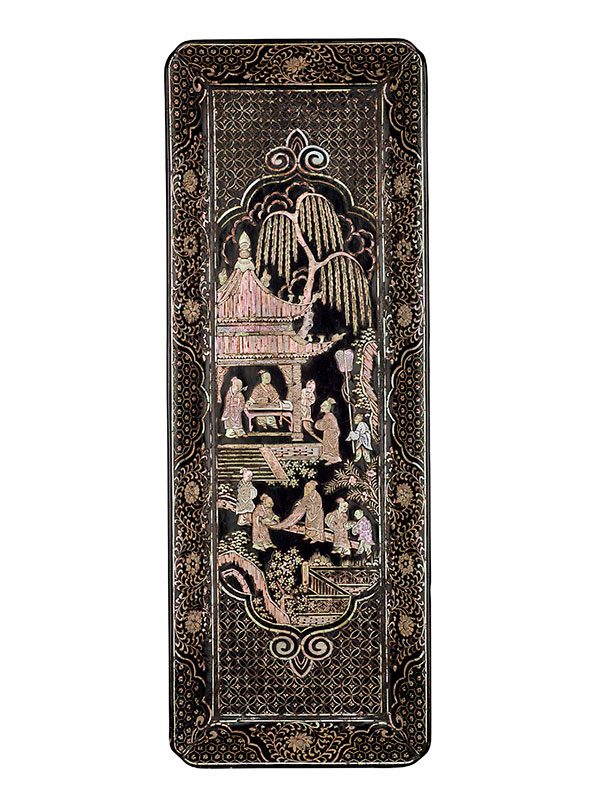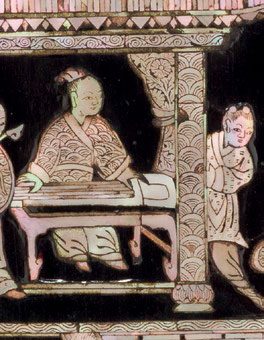Mother-of-pearl inlaid lacquer tray
A lacquer rectangular tray inlaid in mother-of-pearl, with indented corners and a slightly flared rim, supported on a short foot. The interior is decorated all over with intricately inlaid designs consisting of finely cut pieces of mother-of-pearl, against a black lacquer ground. The centre of the flat surface depicts scholars in a garden setting. There is a tiled pavilion on the upper left under a willow tree, with a scholar playing a string instrument inside, accompanied by two attendants, whilst a visitor approaches him. A group of scholars examine a scroll painting in front of the pavilion, beside garden railings and stones. The scene is contained in a bracketed cartouche, against a background of interlaced coin pattern. The flared sides are decorated with flower blossoms amongst swirling tendrils, separated by shaped cartouches containing hexagonal diapers. The exterior is lacquered black. The tray is contained in a silver pouch and a Japanese wooden box.
This type of rectangular tray with shallow sides was most possibly used for folded scrolls, as its name zhoupan (‘scroll tray’) suggests. Furniture and daily utensils inlaid with mother-of-pearl were used by the upper classes of the Northern Song dynasty (960 – 1127). The technique became popular with common people during the Yuan dynasty (1279 – 1368), and came to a crescendo during the Ming dynasty. Heavily influenced by jiehua, a kind of painting style with detailed architectural motifs, the design of Yuan to early Ming dynasty pieces appears with buildings as major elements and with figures playing a subordinate role.1 Two examples dated earlier to the 14th century of the Yuan dynasty, decorated with a comparable hexagonal ground, are in the Tokugawa Art Museum.2 Two comparable Ming dynasty examples, both similar in the cartouche design and interlaced coin pattern, are in the Muwen Tang collection; one is especially comparable with the jiehua style design.3 Three further examples are dated between the 15th and 16th century: one similar in the cartouche design and depicting a dragon amongst waves is in the Klaus F. Naumann collection; 4 one depicting a landscape scene is in the collection of the Victoria and Albert Museum;5 one depicting figures in a landscape setting with a closely comparable floral scrolling design on the sides is in the Garner collection and was exhibited at the British Museum in 1973.6
Provenance: private collection, Japan
- Kwan, S. Chinese Mother–of-Pearl, The Muwen Tang Collection Series, Muwen Tang Fine Arts Publications Ltd, Hong Kong, 2009, p. 35
- Karamono: Imported Lacquerwork – Chinese, Korean and Ryukyuan (Okinawa), Selections from The Tokugawa Art Museum vol. II, nos. 124, 125, pp. 68, 69
- Kwan, S. op. cit. nos. 37 and 62, pp. 118-9, 182-3
- Velt, W. A Japanese Taste for Lacquer- The Klaus F. Naumann Collection, Museum für Ostasiatische Kunst, Berlin, no. 59, pp. 150-1
- Krahl, R. From Innovation to Conformity-Chinese Lacquer from the 13th to 16th centuries, Bluett & Sons, London, 1989, no. 32, p. 82
- Chinese and Associated Lacquer from the Garner Collection, the British Museum, London, 1973, no. 129, pl. 50c, p. 38


